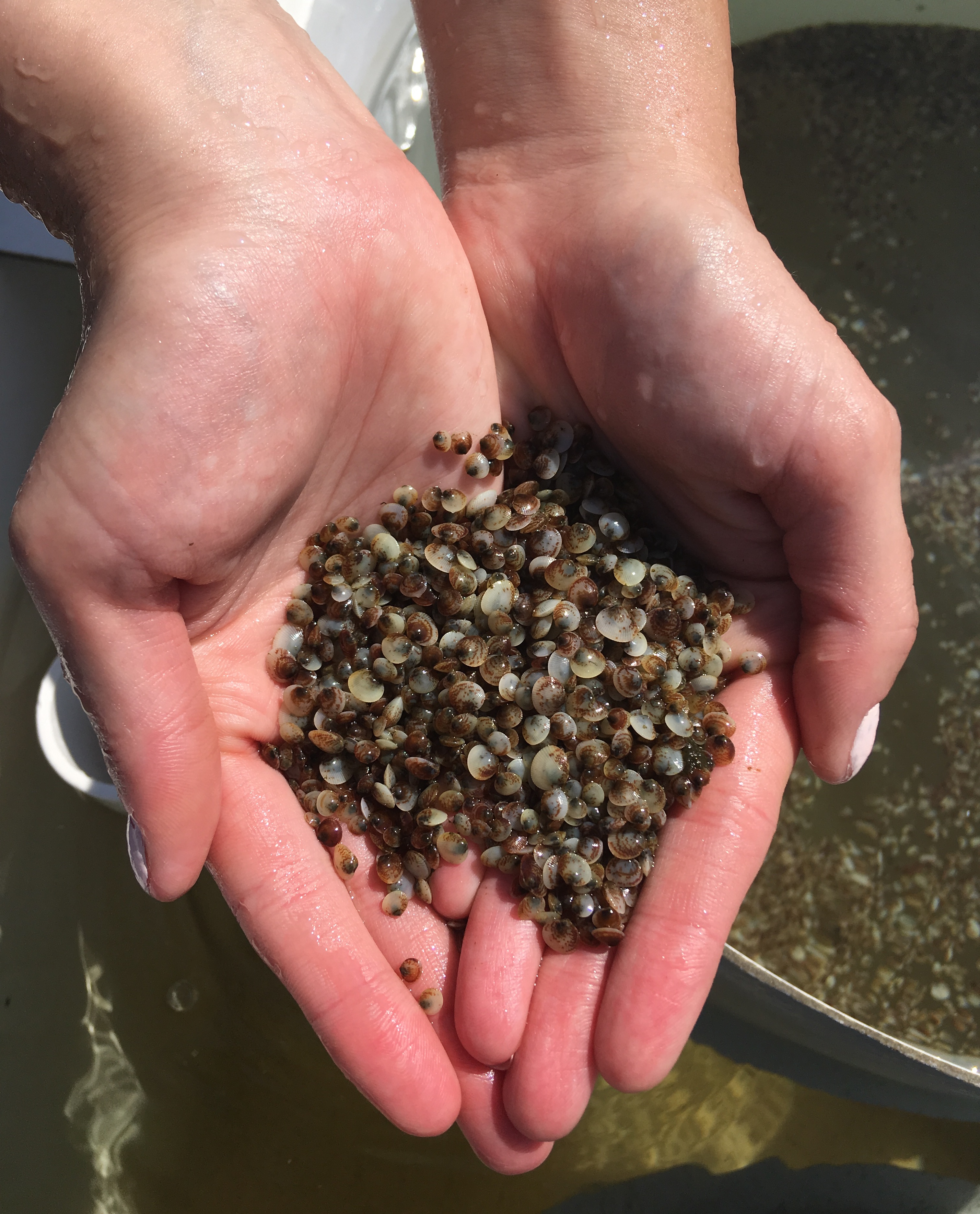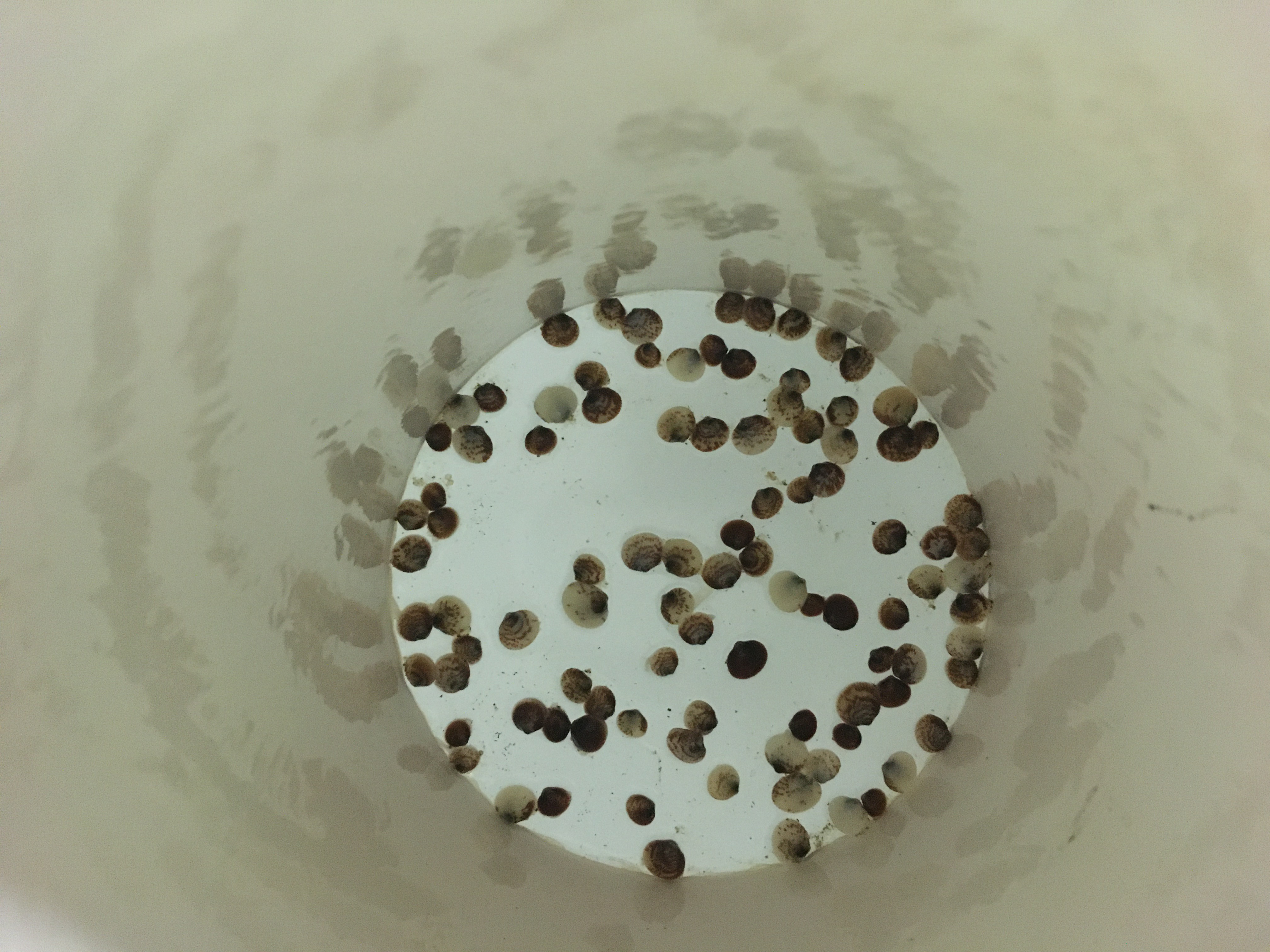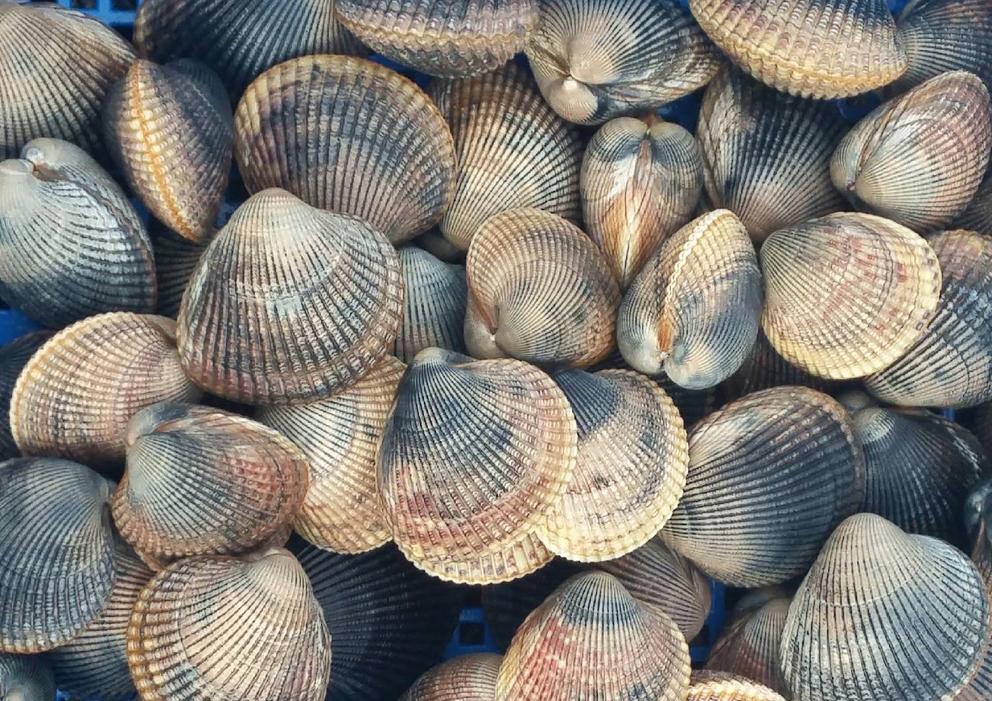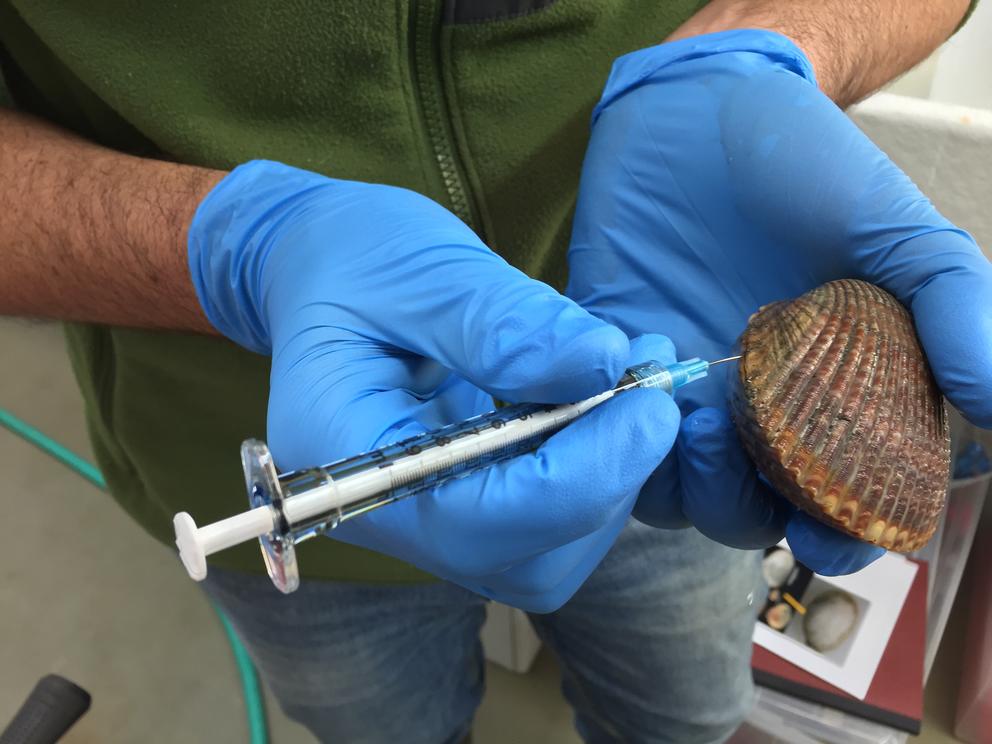Sigo is worried about the Salish Sea and her disappearing culture — which includes her tribe’s access to the traditional foods they rely on.
“Cockles represent that family time, summertime and connection [to this] place that my ancestors have been in since time immemorial,” she says. “I [want] to pass that on to my kids.”
Tribal shellfish biologist Elizabeth Unsell says many tribal members have noticed declines over the decades.
“We don't have data to support that locally, but our recent data do not show a high abundance of cockles on beaches where traditionally there was,” she says. “We want to be able to seed cockles onto traditional cockle beaches in order to increase subsistence access to cockles for tribal members.”
So in 2016, Unsell approached the Puget Sound Restoration Fund (PSRF) about what to do.
The fund specializes in rearing native species in hatcheries, and hatchery research manager Ryan Crim suggested bringing cockle broodstock to PSRF's hatchery operation at the National Oceanic and Atmospheric Administration's Manchester research station, to experiment with spawning and rearing.
While PSRF and Unsell experimented with spawning in 2017 and 2018, the Suquamish Tribal Council eventually put up between $10,000 and $20,000, Sigo says, in late 2018 to jump-start the project.
“It's not that much money for the possibility of having this traditional food back in our lives on a regular basis,” says Sigo, currently the Suquamish Tribal Council treasurer.
Whether cockles are decreasing throughout the Salish Sea area and need restoration remain unknown.
“Drivers of clam populations, including for cockles, are not perfectly understood,” says Chris Eardley, Puget Sound shellfish policy coordinator at Washington Department of Fish and Wildlife. The cockle population has seen declines on individual beaches, while other bivalves like littleneck clams have seen regional patterns in die-offs recently. In addition to mass mortality events, factors affecting cockle survival include "predation, harvest pressure and a whole suite of environmental factors," Eardley says.
While population numbers ebb and flow, Fish and Wildlife’s annual cockle population surveys have all fallen within the range of normal, says Camille Speck, the department's Puget Sound intertidal bivalve manager. “I would say [there’s] nothing that's called out huge concern because it has been such a cyclic response in our annual surveys,” she says.
But even in the absence of historical data, the tribe’s concern persuaded PSRF to act. “[We wanted to] push our scientific understanding to a new level with a really traditionally important species that's had a pretty big impact on the people of the West Coast for thousands of years,” says Crim, the PSRF hatchery research manager.
Over the past three springs and summers, the Suquamish, along with PSRF and NOAA and with guidance from Fish and Wildlife, have developed strategies on how to increase the cockle population in natural habitats. After many stops and starts — including a mysterious clam cancer that threatened the entire project — they succeeded this year in breeding more than a million juvenile cockles. Tribal members will use this batch for ceremonial and sustenance purposes; if wild cockles need restoration help down the line, the team is a step closer to knowing how to start.
Spawning cockles
While they’re sold as bait for Dungeness crabs and occasionally harvested recreationally outside of Coast Salish tribes, cockles aren’t high-priority research subjects. Experts like Crim say it’s become “glaringly obvious” that we don’t know much about them, including their genetics, immune responses, resilience to changing oceans, or even how many there are.
Fish and Wildlife has tracked their numbers since at least the 1970s, but in some ways incidentally. They’re counted during surveys of more popular animals like Manila clams, Crim says.
Giving a number, or even a range of numbers, for the population is tricky: There’s high variance in the sampling, says Speck, the Fish and Wildlife intertidal bivalve manager.
“Surveys cover only a small fraction of Puget Sound shorelines and only a portion of cockle habitat,” adds Fish and Wildlife's Eardley. “Without knowing the full extent of cockle habitat across Puget Sound and across tidal elevations, and the geographical variability in cockle population dynamics, it is difficult to make a total population estimate.”
Tribes are attempting to fill the knowledge gap. The Swinomish used a long-term Fish and Wildlife dataset to evaluate possible reasons for clam declines in 2018.
While Swinomish scientists have "seen declines in cockles on some beaches, we need longer datasets to confirm if these declines truly do exist,” says Julie Barber, senior shellfish biologist with the Swinomish Indian Tribal Community. “They might be more affected by local factors — so some beaches may be in decline while others may be increasing.”
Researchers are deriving much new information while attempting to spawn and rear an under-the-radar native species.
“The state [is] stretched pretty thin in terms of their ability to sort of spin off on projects focused on the animals that don't have a lot of either commercial value or recreational interest,” says Unsell, the Suquamish shellfish biologist. “This is a unique project because it is a native species that is not commercially important in Washington state — it's only because it's culturally important to the tribe that we are able to spend time and money on this.”
After discussing a project in 2016, PSRF and the Suquamish started experimenting with cockle spawning and handling in the spring and summer of 2017. Bivalves, Crim says, often spawn when you take them out of their comfort zone — even changing the temperature of bivalves’ tanks by 5 degrees in either direction usually does the trick. Not so with cockles.
“We tried all sorts of different things,” Crim says, “and we couldn't get them to spawn.”
After that season and again in 2018, they came up empty.
Cancer diagnosis
“Since this is a native species we don't know much about, we [also] don't know a lot about what diseases or parasites and pathogens are naturally prevalent in wild populations,” Crim says. The team had to apply for permits and send animals through disease testing before bringing broodstock in for all three rounds of spawn experimentation.
Ahead of a second season of attempts in 2018, a standard disease screening showed low-level signals of disseminated neoplasia, a rare cancer that can be contagious. At least 15 bivalves species worldwide have been infected, including a native Puget Sound mussel.
Fish and Wildlife didn’t sound the alarm until the 2019 season, when two rounds of testing revealed similar results for another batch of cockles.
Neoplasia impacts species differently. “Sometimes [their] body just fights it off and it goes away,” Unsell says. “If it's not deadly, it could just reduce their ability to either reproduce or survive another stressor.”
But the second set of positive tests raised flags for Fish and Wildlife. Without knowing how many cockles were infected or how infectious the cancer was, the state asked PSRF to halt experiments. PSRF had to figure out how to screen breeding animals for cancer before continuing.
They knew how to do that — but not without hurting the cockles first, or frightening them into spawning prematurely. So this past March, Crim brought in NOAA postdoctoral research fellow Dr. Lauren Vandepas to tackle the problem quickly.
“I had to find a way to test [dozens of clams’] blood for traces of this contagious cancer without pissing them off or killing them,” Vandepas says. People usually dissect bivalves sampled for cancer, but the team needed these cockles alive. “We had this very narrow window of time when the animals were capable of spawning, to screen them and clear their disease checks before they spawned in individual quarantine and ruined chances for captive breeding this year.”
Vandepas, a cell biologist studying cellular components of oyster immune systems, researches how marine invertebrates handle disease: the genes involved, what cells look like, where they are, their offensive and defensive tactics and more.
“We — humans and vertebrates generally — have macrophages and T cells and B cells that all have these different roles in our immune system, but what type of immune cells oysters have [and how they work] is not really well described,” she says.
Vandepas tried a few techniques to test whether disease was present. The winning set of screening methods involved histology — the study of biological tissue — through which Vandepas stained cell structures with different dyes to highlight physical differences between healthy blood cells and ones with cancer. She also used flow cytometry, which, through the help of a laser, lets researchers examine individual cells to identify enlarged nuclei indicative of neoplasia.
But for the physical task of drawing samples, speed was key. The team had to remove clams from individual aquarium quarantines and — as quickly as they could, one by one — stick tiny needles through openings in their shells into muscles; draw blood; and put them back in water.
“We weren't sure if they would all stress-spawn immediately after being disturbed, so this was a little nerve-racking,” Vandepas says.
This combination got the job done.
“I had a two-week time window, which is completely insane, but somehow everybody pulled it off,” Vanderpas says.
“It totally worked,” she says, “and nothing works the first time. We made educated guesses but hadn't tried any of this before — and [to] have it work one-off, on this really tight schedule, was probably a first for me professionally.”
To the breeding zone
Thanks to Vandepas’ technique, the race to spawn was on.
“Lauren is amazing and we, as a result, were able to bring in known noninfected animals to our hatchery,” Crim says. “Finally we were like, OK, well, let's take it to the next level [in 2019].”
That involved injecting tiny amounts of serotonin into the cockles’ gonads, something shellfish researchers elsewhere have had success with. “That seemed to be the ticket for us … They spawned within minutes.”

They then set about making the population healthily diverse. Typical hatchery operations will throw all their broodstock in one tank and let the animals spawn as they may, Crim says.
“Nothing's really controlled in that environment — you often get one male that's fertilizing 95% of the eggs and very, very low diversity — everybody's a half sibling,” Crim says. “For native species that are going to be reared in their native environment, that's a pretty big genetic risk.”
Plus, cockles are hermaphrodites that can fertilize their own eggs, “which is worse than half-siblings,” Crim says.
While the researchers tried to spawn single cockles in their own tanks, the animals spawned better in controlled tanks with lots of individuals.
Using group spawns, serotonin injections and Vandepas’ screening method, the tide turned: This year, between 15 and 20 of the 30 total breeding animals spawned multiple times to produce a cumulative million-plus babies — “a huge number,” Crim says. The biggest ones are barely more than a centimeter in size.
They’re being suspended in cages off the docks at the Manchester facility, with about 180,000 of them in cages in tribal waters, all isolated from wild populations. The team hasn’t decided where the juveniles will eventually end up, but they regardless will grow out in oyster bags.
Releasing so many babies directly into the wild would be risky. “You can really swamp a wild population,” Crim says. “You [need] the knowledge and protocols down for producing really diverse seed — but we're just not there yet.”
Unsell says the tribe isn’t planning to monetize the project. “There is potential for that in the future, but we're not even close to that at this point,” she says.
Research is just beginning
PSRF and Suquamish submitted joint grant proposals and found funding to continue research on some fundamental cockle mysteries: their numbers, their resilience to climate change and even the nature of cancer immunity.
“There's a lot of research coming out of this project that may not have been prioritized by other groups, and this project will be contributing a lot to the understanding of this species in the state of Washington and Puget Sound,” says Fish and Wildlife’s Eardley.
The Suquamish are leading dive missions to survey subtidal cockle populations that would give us a better idea of just how many there are in the Salish Sea. They are also coordinating with other tribes to collect cockles from around the region for genetic testing to get a sense of diversity in Puget Sound.

Meanwhile, the team will evaluate cockles for cancer. Using Vandepas’ technique, PSRF and Vandepas are attempting to show neoplasia’s reach throughout Puget Sound cockles. They’ve begun collaborating with Dr. Michael Metzger of Pacific Northwest Research Institute, whose lab studies how normal cells become cancerous, and how cancer cells operate. They may also learn more about the timing of a cancer outbreak in populations, and why some clams are susceptible while others aren’t.
PSRF also received funding for lab trials into cockles’ resiliency to ocean acidification, which hurts many shellfish species’ shell development.
Answering questions like that may help researchers find habitat-based methods to support wild cockle populations, Speck says, instead of introducing genetically risky hatchery seed.
If they find that cockles across locations have similar genetic structures, they may be able to transplant cockles from dense populations to Suquamish beaches without endangering the local population. For instance, geoduck farmers in South Puget Sound frequently find their geoduck tubes full of cockles. “We would love to figure out a way to kill two birds with one stone here,” Crim says. Understanding why cockles do well there, while removing them to environments where people want them, could help give people a better idea of how cockles build environmental resilience.
For now, the mere spawning success represents a huge step for people like Sigo, who recently visited the juveniles.
“Getting to look at them and see how cute they were climbing up the sides, I mean, it was a tearful moment, a joyful moment,” she says. She scooped up a handful of 70,000 babies.
“The possibilities seemed endless,” she says. “I'm excited for the day when my family and my tribe get to have this amazing cockle bake and give thanks to this amazing shellfish that people don't really know about, that really hold a special place in our hearts and our history.”





